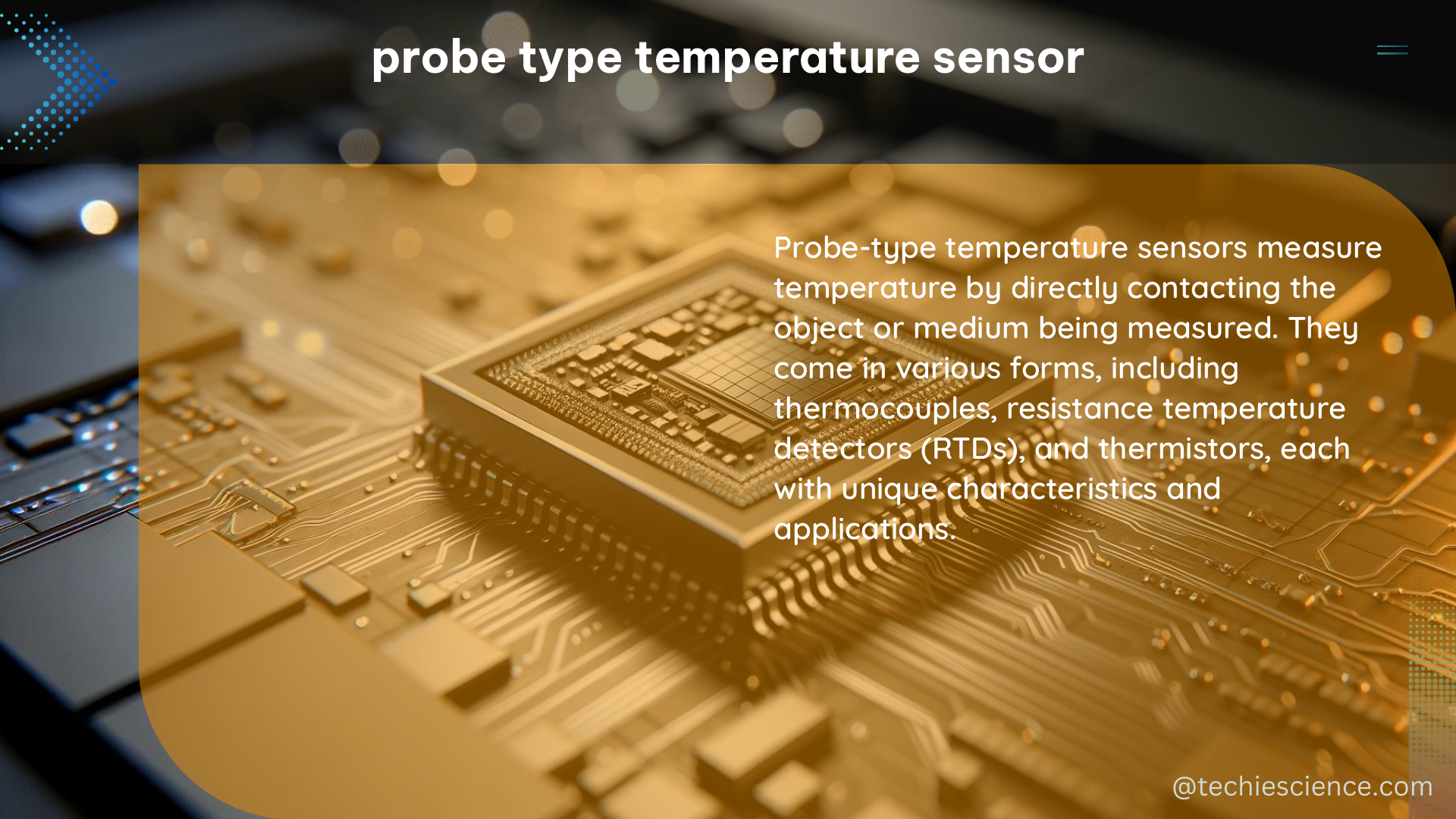Probe type temperature sensors, also known as contact temperature sensors, are essential tools for measuring the temperature of objects or media in a wide range of applications, from medical to industrial. These sensors come in various forms, each with its unique characteristics and capabilities, making it crucial to understand the intricacies of each type to select the most appropriate one for a given application.
Thermocouples: The Versatile Choice
Thermocouples are one of the most common types of probe temperature sensors, consisting of two dissimilar metal wires joined at one end. This junction creates a voltage that is proportional to the temperature difference between the junction and a reference point. Thermocouples are known for their:
- Wide Temperature Range: Thermocouples can measure temperatures ranging from -200°C to 2,300°C, making them suitable for a variety of applications.
- Ruggedness: Thermocouples are relatively inexpensive and can withstand harsh environments, making them a popular choice for industrial applications.
- Simplicity: The basic design of thermocouples allows for easy installation and maintenance, contributing to their widespread use.
However, thermocouples have some limitations, including:
– Lower Accuracy: Compared to other probe type sensors, thermocouples generally have lower accuracy, typically ranging from ±0.5% to ±2% of the measured value.
– Susceptibility to Electrical Interference: Thermocouples can be affected by electrical noise, which can introduce errors in the temperature measurements.
Resistance Temperature Detectors (RTDs): Precision and Stability

RTDs, on the other hand, use a coil of fine wire, usually made of platinum, to measure temperature. The resistance of the wire changes with temperature, allowing for highly accurate measurements. RTDs are known for their:
- High Accuracy: RTDs can achieve accuracies of ±0.1% or better, making them suitable for critical applications where precise temperature measurements are essential.
- Excellent Stability: RTDs maintain their accuracy and stability over time, making them a reliable choice for long-term monitoring applications.
The main drawbacks of RTDs include:
– Higher Cost: RTDs are generally more expensive than thermocouples, which can be a limiting factor in some applications.
– Limited Temperature Range: RTDs are typically limited to a temperature range of -200°C to 850°C, which may not be suitable for all applications.
Full System Thermometers: Compact and Cost-Effective
Full system thermometers, such as thermistors and integrated circuit temperature sensors, provide a complete temperature measurement system in a single package. These sensors are known for their:
- Compact Size: Full system thermometers are often smaller and more compact than other probe type sensors, making them ideal for applications where space is limited.
- Cost-Effectiveness: Compared to thermocouples and RTDs, full system thermometers are generally more cost-effective, making them a popular choice for applications where budget is a concern.
- High Accuracy: Many full system thermometers can achieve accuracies comparable to or even better than RTDs, depending on the specific sensor technology used.
The main drawback of full system thermometers is their limited temperature range, which is typically narrower than that of thermocouples and RTDs.
Other Probe Type Temperature Sensors
In addition to the three main types of probe temperature sensors, there are several other options available, including:
- Bimetallic Thermometers: These sensors use the differential expansion of two dissimilar metals to measure temperature changes.
- Infrared Thermometers: These non-contact sensors measure the infrared radiation emitted by an object to determine its temperature.
- Liquid-in-Glass Thermometers: These traditional thermometers use the expansion of a liquid, such as mercury or alcohol, to indicate the temperature.
Each of these sensor types has its own unique characteristics and applications, and the choice of the appropriate sensor will depend on the specific requirements of the application.
Selecting the Right Probe Type Temperature Sensor
When selecting a probe type temperature sensor, it is essential to consider the following factors:
- Temperature Range: Ensure that the sensor can measure the expected temperature range of the application.
- Accuracy: Determine the required level of accuracy for the application and select a sensor that can meet or exceed that requirement.
- Response Time: Consider the speed at which the sensor needs to respond to temperature changes, as this can vary significantly between different sensor types.
- Environmental Conditions: Evaluate the environmental factors, such as humidity, pressure, and chemical exposure, that the sensor will be subjected to and select one that can withstand those conditions.
- Cost: Determine the budget for the application and select a sensor that provides the best value for the money.
By carefully considering these factors, you can ensure that the selected probe type temperature sensor will meet the specific needs of your application and provide reliable and accurate temperature measurements.
Conclusion
Probe type temperature sensors are essential tools for a wide range of applications, from medical to industrial. By understanding the unique characteristics and capabilities of each sensor type, you can make an informed decision and select the most appropriate sensor for your needs. Whether you require the versatility of thermocouples, the precision of RTDs, or the cost-effectiveness of full system thermometers, this comprehensive guide will help you navigate the world of probe type temperature sensors and make the best choice for your application.
References:
- Temperature Measurement – MST.edu, https://web.mst.edu/~cottrell/me240/resources/temperature/temperature.pdf
- Which Site is Better for Skin Sensor Temperature Probe in Neonatal Care, https://www.ncbi.nlm.nih.gov/pmc/articles/PMC9704484/
- Detection and quantification of temperature sensor drift using probabilistic neural networks, https://www.sciencedirect.com/science/article/pii/S0957417422019029
- Temperature Sensors – Engineering LibreTexts, https://eng.libretexts.org/Bookshelves/Industrial_and_Systems_Engineering/Chemical_Process_Dynamics_and_Controls_(Woolf)/03:_Sensors_and_Actuators/3.02:_Temperature_Sensors

The lambdageeks.com Core SME Team is a group of experienced subject matter experts from diverse scientific and technical fields including Physics, Chemistry, Technology,Electronics & Electrical Engineering, Automotive, Mechanical Engineering. Our team collaborates to create high-quality, well-researched articles on a wide range of science and technology topics for the lambdageeks.com website.
All Our Senior SME are having more than 7 Years of experience in the respective fields . They are either Working Industry Professionals or assocaited With different Universities. Refer Our Authors Page to get to know About our Core SMEs.